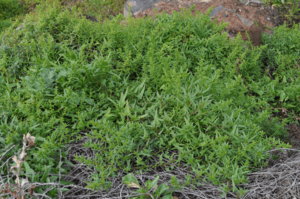Genetic diversity of Patellifolia species (GeDiPa)
Activity Coordinator: Lothar Frese Email
The project on “Genetic diversity of Patellifolia species (GeDiPa)”, submitted by the Beta and Wild Species Conservation in Genetic Reserves Working Groups for funding under the First Call of the ECPGR Activity Grant Scheme, was selected by the Executive Committee in December 2014.
- Activity proposal (122,9 KB)
Background
The action aims at a better understanding of the spatial distribution of genetic diversity within the genus Patellifolia, the establishment of taxonomic standard accessions as well as the identification of MAAs for AEGIS and to (re)visit sites recommended for the establishment of genetic reserves by the AEGRO project team.
Implementation
Partners in Spain, Portugal and Germany jointly analysed the patterns of genetic diversity of the genus Patellifolia, a crop wild relative of cultivated beets. The action aimed at the identification of collection gaps and the identification of Most Appropriate Accessions (MAAs) and Most Appropriate Wild Populations (MAWPs) on an informed basis. To this end, a set of polymorphic SSR markers for Patellifolia was developed and used to study the geographic distribution of genetic diversity within the species as well as the genetic differentiation between occurrences sampled in the distribution area on site. The results were published online in the final Activity report as well as in two open access papers available on this page.
July 2017
- Paper published in Euphytica
Frese L, Bülow L, Nachtigall M. et al. 2017. Genetic diversity of Patellifolia patellaris from the Iberian Peninsula, a crop wild relative of cultivated beets (1,3 MB). Euphytica 213:187. Erratum (230,2 KB)
- The Final Activity report is now available
Genetic diversity of Patellifolia species (GeDiPa) – Final Activity Report (949,1 KB)
January 2017
The genetic diversity of Patellifolia is being investigated to generate information required for the organization of a systematic genetic resources conservation action combining the best elements of the ex situ and in situ conservation concept. To this end, the project team has sampled material on the Iberian Peninsula and on islands of the Macaronesian Archipelago. The laboratory work was completed in late 2016. Three separate sets of microsatellite data have been produced: a) P. patellaris sampled on the Iberian Peninsula in Portugal and Spain, b) P. patellaris from several of the Canary Islands, from Madeira and the Cape Verde Islands and c) P. procumbens from Tenerife and P. webbiana from Gran Canaria.
Ten occurrences of P. patellaris were sampled on the Iberian Peninsula in Portugal and Spain. A total of 271 individuals was analysed using 24 microsatellite markers. The factorial analysis separated the material into two occurrences from Portugal, two occurrences sampled east of Gibraltar and six occurrences from the eastern Spanish coast. This part of the small action “Genetic diversity of Patellifolia species (GeDiPa)” was finalized in late 2016 and submitted for publication in January 2017.
The preliminary factorial analysis of the P. patellaris material sampled on the Canary Islands, Madeira and Cape Verde Islands splits the material into groups which can be explained by geographic or biological factors. A similar analysis of P. procumbens occurrences from Tenerife shows that the material can be roughly separated in an eastern and western group. Furthermore, the factorial analysis clearly separates P. webbiana from Gran Canaria from P. procumbens. As the laboratory work and statistical analysis is being financed on an input-in-kind basis by the GeDiPa partners, the thorough analysis of the whole set of microsatellite and cytological data did not progress as fast as was hoped. The preliminary results are very encouraging and the GeDiPa team is eager to finalize the study in 2017.
September 2016
The publication on Patellifolia SSR markers is now available
- Nachtigall M, Bülow L, Schubert J, Frese L. 2016. Development of SSR Markers for the Genus Patellifolia (Chenopodiaceae). Applications in Plant Sciences 4(8):1600040. 2016
January 2016
The Interim Activity Report (covering the period February- December 2015) is now available
October 2015
The marker analysis of the material collected in south-east Spain should be completed by mid-November, after which the statistical analysis of this data set will be started. The project will then continue with the other samples as planned.
Collected seed samples have been sent to the national genebanks.The primer note passed the internal procedures. When all SSRs will have been sequenced, the sequences will be submitted to the NCBI / GenBank. After successful submission the primer note will be sent for publication in Applications in Plant Sciences.
February 2015
The coordination meeting of the GeDiPa project was held 17 February 2015 at Universidad Rey Juan Carlos, Madrid, Spain.
- Agenda (7,2 KB)
- List of participants (133,6 KB)
Following the meeting, the project partners carried out sampling of plant occurrences of P. patellaris and P. procumbens. For that purpose sites on the Capverdian Islands, in southeastern Spain and Tenerife, in mainland Portugal and on the Madeira archipelago were visited. Seeds have been collected to close geographic gaps in the European PGR holding. The new accessions will be deposited in the respective national genebank. Leaf samples were harvested for cytological analysis to determine the ploidy level and the occurrence of hybridization between P. patellaris, known as tetraploid species, and the diploid species P. procumbens. Twenty-five polymorphic SSR markers were developed and tested. This set is suited to analyse genetic diversity of P. patellaris, P. procumbens and P. webbiana. A primer note is currently being prepared for submission.
